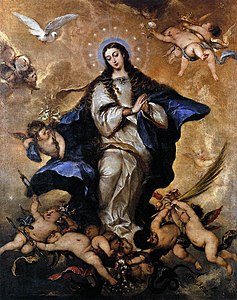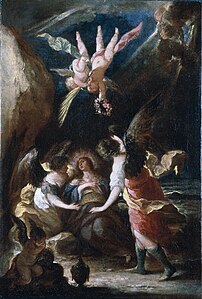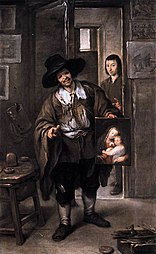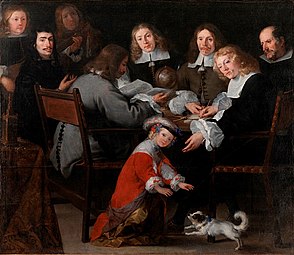José Antolínez
José Antolínez (* 1635 in Madrid , † May 30, 1675 in Madrid) was a Spanish Baroque painter from the Madrid School.
biography
José was the son of Ana de Sarabia and the wealthy cabinet maker Juan Antolín, who, in addition to his residence in Madrid, also owned a property in Espinosa de los Monteros . The child was baptized on November 7, 1635 in the church of S. Justo y Pastor in Madrid with the first name Claudio José Vicente . Like his brother Francisco, José later had aristocratic pretensions, and in 1662 tried to gain recognition as a Hidalgo .
He began his training with the simple painter Julián González de Benavides, who became his father-in-law in 1653. He later moved to Antonio Palomino and Francisco Rizi . He also attended the open academies in Madrid. In his biography, Palomino does not paint a very likable picture of Antolínez, he describes him as a haughty and vain man, with a sharp tongue and a biting, mocking sense of humor, and skillful with the sword. His arrogant behavior is said to have repeatedly led to friction and arguments with colleagues, for example he fell out with his teacher Rizi. Even so, his painting was highly valued by his contemporaries.
His relatively early death at the age of 40, on May 30, 1675, is said to have caused him himself through excessive pride and his love for the "black sword" ( espada negra ); he was beaten up during a quarrel with other “aficionados” and died a few days later.
According to Palomino, he had a student named Alonso del Barco , a landscape painter.

plant
Antolínez was a very versatile and original artist who left behind a relatively extensive work and cultivated a wide variety of genres: religious painting, mythology , portraits , genre scenes and landscapes - but nothing of the latter has survived. What is remarkable is the large number of works dedicated to the theme of the Immaculate Conception ( Maria Immaculada ), comparable only to the Sevillian master Murillo . About twenty copies by Antolínez have survived, three of them signed in the Prado. In doing so, he succeeded in creating "... an iconographic type of extreme elegance and sophistication ...". The versions in the Ashmolean Museum , Oxford, and in the Museo de Bellas Artes in Bilbao are particularly elaborate and of exceptional beauty .
Antolínez's interpretations of Maria Magdalena also stand out, particularly that of the Prado, where he depicts the Ascension of the saints in a dynamically moving diagonal composition in rich blue tones.
It is worth mentioning some works that he created in genres less frequented by other Spanish artists, such as B. The poor painter in the Alte Pinakothek , Munich, or the group portrait - including the painter's self-portrait - by Ambassador Lerche from Copenhagen. Two portraits of little girls in the Prado have long been the work of Velázquez since the 19th century, but were attributed to Antolínez by Diego Angulo in 1957.
- Religious painting (selection)
Inmaculada Concepción , approx. 1665, 201 × 149.5 cm, Museo de Bellas Artes , Bilbao
Annunciation , approx. 1665–1675, 203 × 153 cm, Hermitage , St. Petersburg
Christ in the Olive Grove , 1665, 167 × 163 cm, Bowes Museum , Barnard Castle
- Other (selection)
Poor art dealer (also: poor painter ), around 1670, 201 × 125 cm, Alte Pinakothek , Munich
The Danish ambassador Cornelius Pedersen with entourage (self-portrait by Antolínez: second from left, seated) , 1662, 186.5 × 215.8 cm, Statens Museum for Kunst , Copenhagen
Girl with Roses , around 1660, 58 × 46 cm, Prado, Madrid (unsigned, previously attributed to Velázquez )
literature
- José Antolínez. Short biography on the Prado website, online , viewed August 14, 2018. (Spanish)
- Diego Angulo Iñiguez : José Antolínez. Instituto Diego Velázquez del Consejo Superior de Investigaciones Científicas, Madrid 1957. (Spanish)
- José Rogelio Buendía: José Antolínez, pintor de mitologías. In: Boletín del Museo e Instituto Camón Aznar. No. 1, 1980, pp. 45-57. (Spanish)
- Colección Santamarca. Pinturas restauradas en 1983 for the Fundación Banco Exterior. Catalog of an exhibition in the Sala de exposiciones del Banco Exterior, Madrid, February – March 1984. ISBN 84-500-9659-6 (Spanish)
- Ismael Gutiérrez Pastor: Novedades de pintura madrileña del siglo XVII: obras de José Antolínez y de Francisco Solís. In: Anuario del Departamento de Historia y Teoría del Arte (UAM). Volume 12, 2000, pp. 75-92. (Spanish)
- Antonio Palomino: El museo pictórico y escala óptica III. El parnaso español pintoresco laureado. Aguilar SA de Ediciones, Madrid 1988, ISBN 84-03-88005-7 (Spanish).
- Alfonso E. Pérez Sánchez: Pintura barroca en España. 1600-1750. Ediciones Cátedra, Madrid 1992. ISBN 84-376-0994-1 (Spanish).
- Suzanne Stratton: La Inmaculada Concepción en el arte español. In: Cuadernos de Arte e Iconografía (FUE), tomo I, vol. 2. 1988, pp. 1-127. (Spanish).
Individual evidence
- ^ Alfonso E. Pérez Sánchez: Pintura barroca en España. 1600-1750. Madrid: Ediciones Cátedra, 1992.
- ^ Antonio Palomino: El museo pictórico y escala óptica III. El parnaso español pintoresco laureado. Madrid: Aguilar SA de Ediciones, 1988, p. 340.
- ↑ José Antolínez. Short biography on the Prado website, online , viewed 14 August 2018.
- ↑ José Antolínez. Short biography on the Prado website, online , viewed 14 August 2018.
- ^ Antonio Palomino: El museo pictórico y escala óptica III. El parnaso español pintoresco laureado. Madrid: Aguilar SA de Ediciones, 1988, p. 340.
- ^ Antonio Palomino: El museo pictórico y escala óptica III. El parnaso español pintoresco laureado. , Madrid ... 1988, p. 392.
- ↑ José Antolínez. Short biography on the Prado website, online , viewed 14 August 2018.
- ^ Diego Angulo Iñíguez: José Antolínez. Madrid: Instituto Diego Velázquez del Consejo Superior de Investigaciones Científicas, 1957.
- ↑ José Antolínez. Short biography on the Prado website, online , viewed 14 August 2018.
- ↑ Information on the Prado website: "Retrato de una niña" , viewed on August 14, 2018. (Spanish)
| personal data | |
|---|---|
| SURNAME | Antolínez, José |
| ALTERNATIVE NAMES | Antolínez, Claudio José Vicente; Antolínez, José Claudio |
| BRIEF DESCRIPTION | Spanish Baroque painter |
| DATE OF BIRTH | before November 7, 1635 |
| PLACE OF BIRTH | Madrid , Spain |
| DATE OF DEATH | May 30, 1675 |
| Place of death | Madrid |








